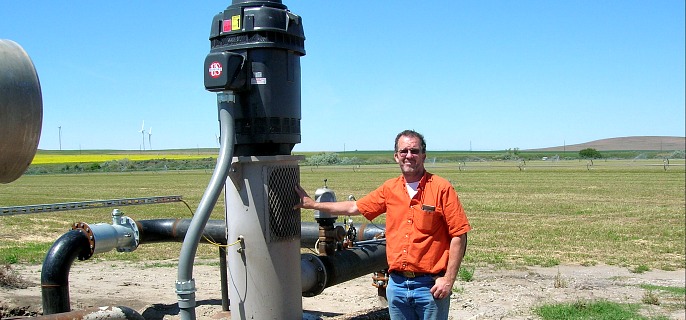[quote style=”2″]Madison Farms Implementing Innovative Hydropower Technology[/quote]
Madison Farms in Echo began using a regenerative drive module this spring to generate electricity during the process of aquifer storage and recovery.
Aquifer storage and recovery (ASR) is the process of injecting potable water into an aquifer for long-term storage. Kent Madison patented the 3R Valve through which the water is injected.
Madison compared the injection process to putting red dye down a straw into a glass of ice water.
“The little red bubble would build at the bottom of the straw,” Madison said. “It displaces the water that’s in there and pushes the native water back out of the way, so you end up with this bubble of your injected water that’s all surrounded by the native water.”
The displaced water becomes a sort of dam stacked above the natural groundwater level. In the case of Madison Farms, this “dam” is 450 feet high.
“It’s energy potential because you’ve got water stacked up 450 feet above the static level of the aquifer. If you allow that water’s energy potential to go through the pump bowls backwards, the pump itself will spin in reverse,” Madison said.
He explained that when certain pump motors used for aquifer injection spin fast enough in reverse, they become generators. “The problem is you can’t spin them fast enough because a pump’s bowls are designed to be efficient to pump water out of the ground and not efficient when water flows back through them,” said Madison.
To overcome this problem, Madison Farms uses a variable frequency drive (VFD), which runs in the same direction as the pump bowls, but slower than the water’s force would naturally cause the bowls to run.
“The VFD creates an electronic brake just like on a Prius,” Madison said. “When you let your foot off the gas on a Prius and the thing starts to go into regenerative mode, the electric motors on the Prius become a generator, and they charge the batteries as the Prius slows down.”
Madison says that if the Umatilla Basin decides to use ASR in efforts to rebuild the area’s aquifers, regenerative drive technology would be a cost-effective option.
“Now you’re generating electricity while you’re shoving water down the well,” he said. “Literally, you’re turning your meter backwards and you’re sending power back onto the grid in the process.” He said that regenerative drive technology reduces the energy cost of ASR by about 40 percent.
Madison Farms prototyped the regenerative drive technology for the Oregon Energy Trust. Right now, Madison and Pendleton Public Works Director Bob Patterson are the only ones in Oregon using this type of system.
Madison Farms currently has the only regenerative drive ASR project for agricultural use. The Tualatin Water District plans to implement regenerative drive technology this fall.
“I haven’t heard anyone else doing it as of yet,” said Madison.
To learn more about regenerative drive technology, visit the hydro generation page at 3rvalve.com.









